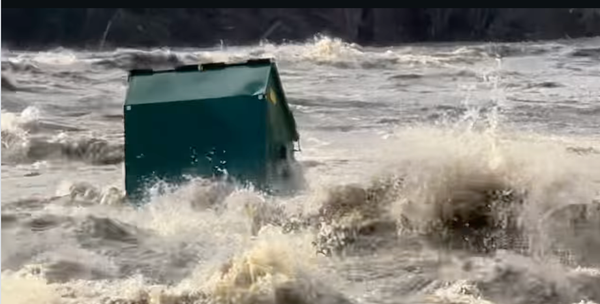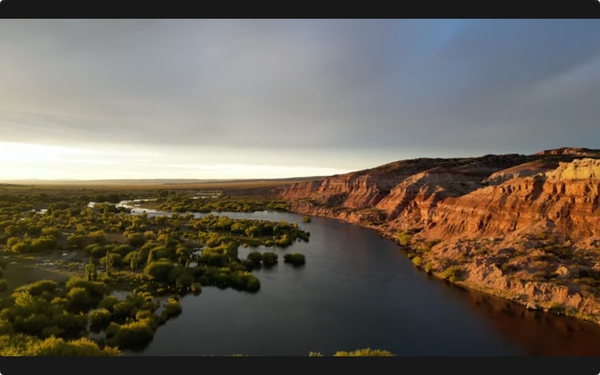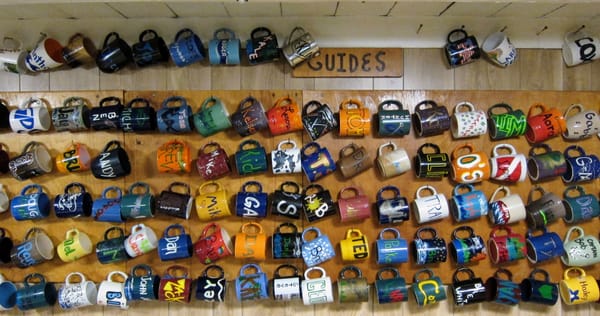How to read a river: Riffles, runs, and pools
Digging one level deeper to understand the different features we find in a river
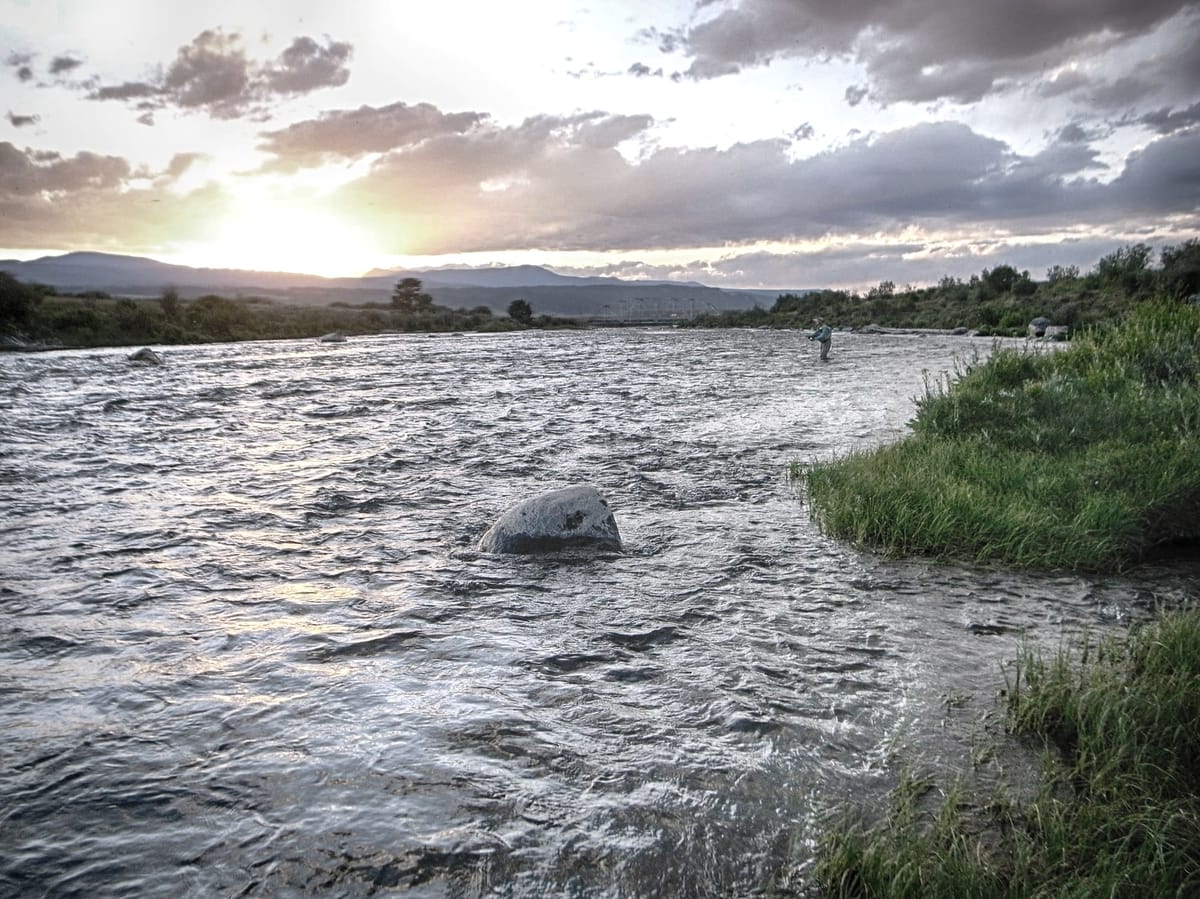
Inside this lesson:
Structural features
River behaviors
Biological elements
Riffles, runs, and pools
Riffles
Runs
Pools
How riffles, runs, and pools happen
Summing up
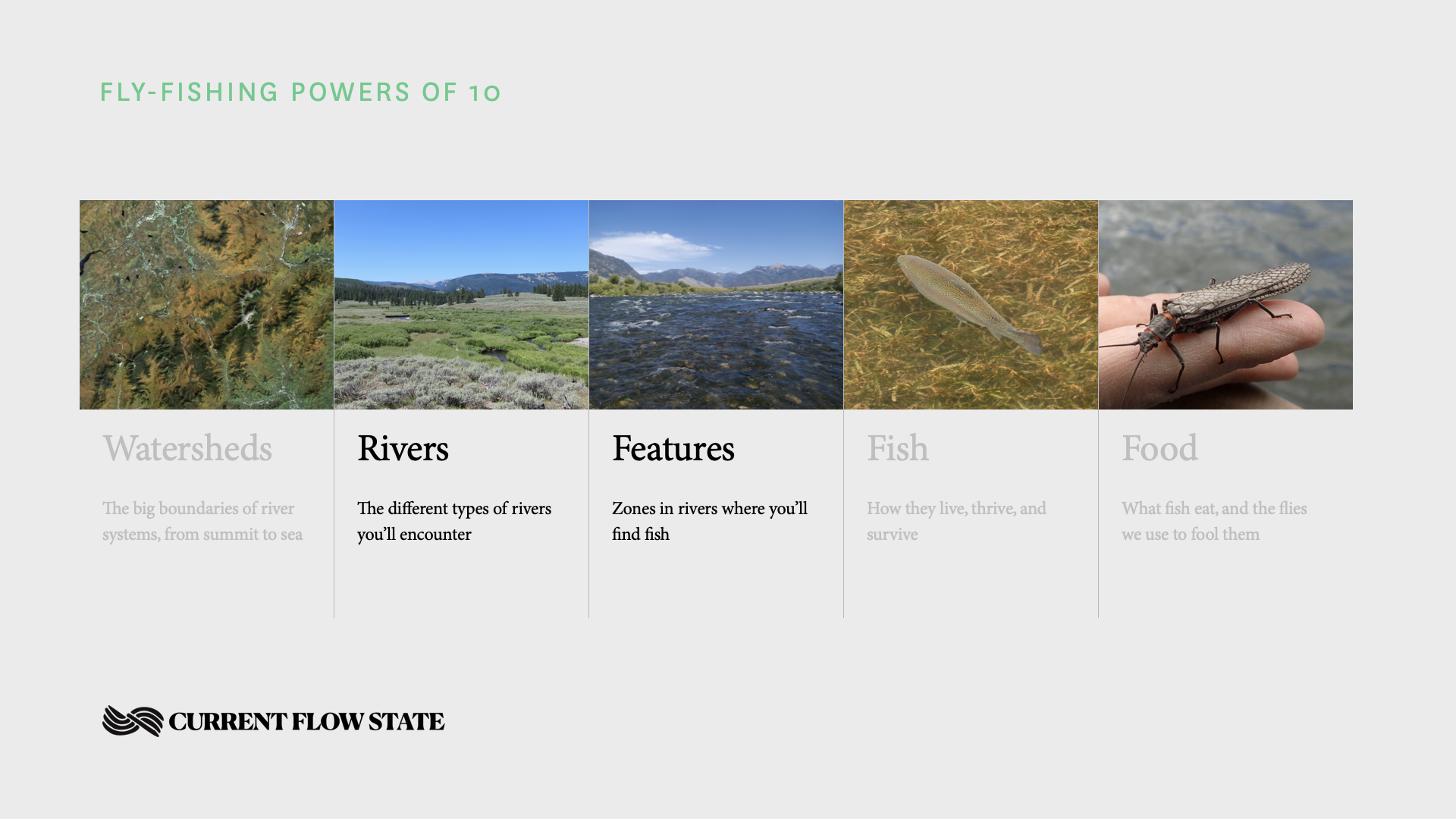
In our Intro to Fly Fishing class, the next level down from Watersheds in our Powers of 10 journey is to the levels of rivers and their features. One of the first activities we do is draw a river on the whiteboard.
It's simple river, to start. Two meandering banks, and an arrow indicating current direction. And then, we ask around for folks to call out what goes into it. As they do, we locate and place these "features" (crude icons and poor attempts at drawing).
It's not a trick question, although it can take a few minutes for everyone to warm up. Intuitively, we know a lot about what we find in rivers. There's a lot of different things—living and not—you'll find in a river.
Rivers contain:
- Banks and boundaries
- Rocks (of all sizes, from sand to boulders)
- Logs and woody debris
- Sediment and decomposed plant material
- Living plants (grasses, algae, moss, trees)
- Living creatures (insects, fish, birds, otters, sometimes humans!)
- Islands and rapids
- Eddies and currents
- Dams and other human-made constraints
- And much, much more
We could carve all these things up into three, probably:
- Structural features
- River behaviors
- Biological elements
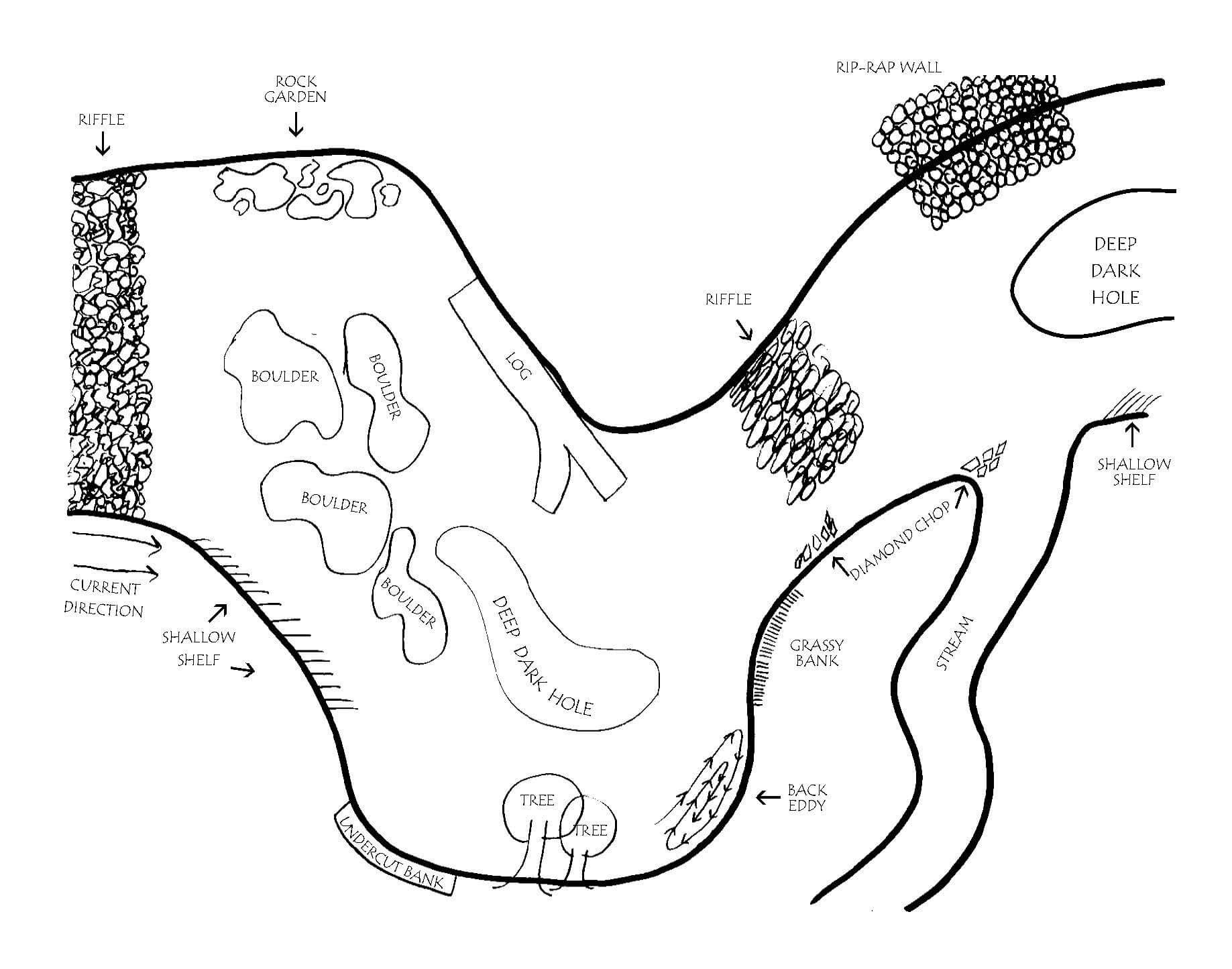
Structural features
Some of these features are structural, meaning, they're core to how the river moves through the earth. Sand and gravel bars, islands, high banks, rip-rap, sandy beaches, and oxbows, where the river seems to double back on itself.
Some of these move around. Cover like logs and boulders move from season to season, pushed down by floods. A couple of structural features are extra-critical to fly-fishing. We pay special attention to them because fish tend to congregate around them.
Undercut banks, shelves, and ledges
Oftentimes the edge of the river is not dead up and down, or sloping up to a beach. A lot of times, banks are deceiving. This can seem like grass or solid ground, but the river's current will have hollowed them out, and they can become a haven for fish.
Overhanging banks make what we call a "lie"—a place fish hang out—in part because they're shaded and cool, in part because they're protected from overhead predators like birds, and in part because they're within striking range of any insects that fall into the water.
It's always good to approach any spot where you might be dealing with an overhang with caution, and consider there might be a large fish holding right at a safe spot at the edge of the river.
Feeder creeks
Oftentimes a river will have another, smaller river or stream coming into it. We call these feeder creeks. Incoming creeks are another great place to think about fishing, especially in the summer. Typically water in a feeder creek will be cooler, giving trout in the main river a place to hang out with more dissolved oxygen.
River behaviors
Rivers are alive, in that their current is constantly changing their structural features and topography, shifting everything from microscopic pieces of sediment to massive boulders in a flood. Rivers carve and re-carve their banks repeatedly, changing course.
Rivers are never straight. Or, at least, they shouldn't be. One of the great monuments to human achievement and hubris of the 19th and 20th centuries was the idea that we should straighten and channelize rivers to reduce flooding. The thinking was, simplified quite a bit, that we just build a bigger trough for floodwaters to get to sea quicker.
What happened in reality was everything alive in the river gets washed out to the sea too, including things like juvenile salmon in their little nurseries, and the fine substrate and sediments that make great bug habitat. So now what habitat restoration groups try to do is to introduce kinkiness, to help make rivers that meander more. They drop huge logs in from helicopters, to make the rivers more natural, sort of give them more character.
Watch this excellent time-lapse of the Ucayali River in Peru, from 1985-2013, as it constantly redefined its banks, even cutting off an oxbow in what's known as an oxbow lake. This is how nature intends things to go:
Here's how we try to fix things, after years of dredging and channelizing and wrecking aquatic habitat:
Seams
One of the most counter-intuitive things about fly-fishing is that water isn't uniformly distributed. One way to illustrate this is with a classic elementary school science experiment:
Temperature variations, water speed, obstacles, turbidity (how much sediment water contains) and more all factor into how water mixes together, or doesn't. Seams develop between these different water types. There'll be kind of parts of the river that seem to be more active and parts that are more placid.
Finding seams, or the areas where two different types of water come together, are critical to finding fish, when we're fly-fishing in rivers. Seams tend to trap fish food, and they tend to offer places for fish to hang out where they're out of the fast lane.
Foam lines are key to finding seams, and the number one indicator of where fish might be hanging out.
"At home in the foam" as one guide used to tell me, as he urged me to get my novice casts into the foam lines.
Eddies
Seams, and the variance of different speeds of water, in part, create eddies. An eddy is a place where the contours of the river create a natural slack zone, where the current either slows, or even goes back on itself and flows back upstream. An eddy can be tiny, just a few feet wide and long, or hundreds of feet long, depending on the size of the river and the strength of its current.
If you're in a raft or a drift boat, an eddy is an ideal place to pull over and chill out. Oftentimes, fish gravitate towards eddies because they give them a break from the main current, and a place where they don't have to expend energy. Any place where a fish doesn't have to expend as much energy is desirable; nature has incredibly thin margins, and fish must constantly eat to survive.
Biological elements
We'll handle these in the next few posts, but by and large, biological elements can be summed up as:
- Plants
- Fish
- Bugs, and other things fish eat
- Larger animals, and things that eat fish
What's important right now is you can understand how structural elements and river behaviors combine to create the ideal habitat for biological stuff, primarily fish and the things they eat.
Riffles, runs, and pools
Even before you worry about seams, or eddies, there's a shortcut to reading a river. It's a bit of shorthand you can apply from the road, before you get out, and rig up. Of the thousand names for water we employ as anglers, three labels will be most useful to you: Riffle, run, and pool.
For purposes of reading water, a river can be divided up into three different parts: riffles, runs and pools. Every river moves through these different sort of phases, just in different stages.
The transitions aren't always cut and dry, but once you start looking, you'll be surprised, Nature sometimes just cuts from one scene to another, and you go from a lot of rocks in the river (hint: riffle) to no rocks, and a deeper pool. You might see how a riffle gives way to a run, with the rocks getting gradually bigger and deeper, and the river widening, creating varying currents as the water type changes.
So dividing rivers up into riffles, runs and pools can help like understand exactly kind of what's happening with the structural composition of the river bottom, and banks, and subsequently, where fish can be found.
Of the thousand names for water we employ as anglers, three labels will be most useful to you: Riffle, run, and pool.
Here's a great diagram:
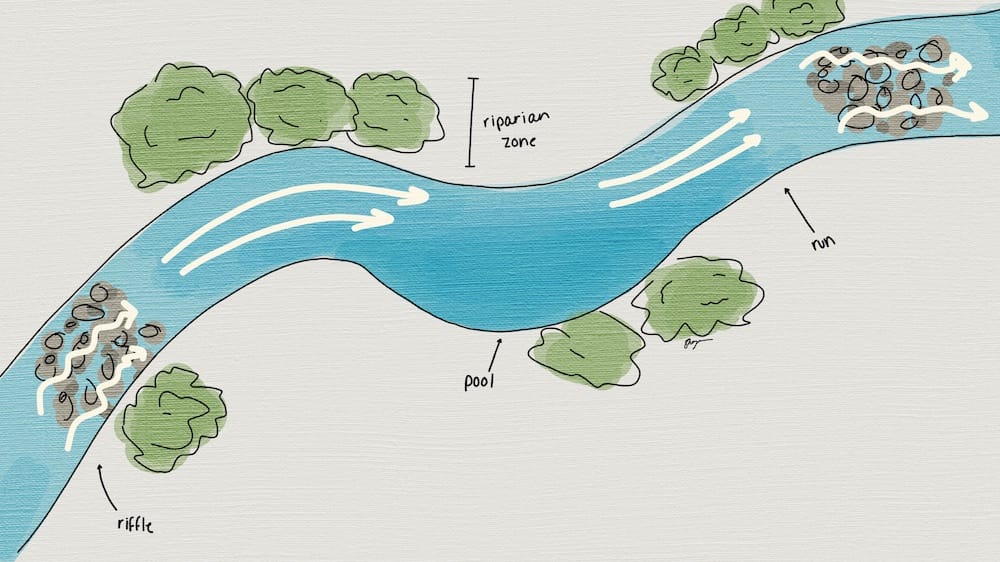
If we were to dig into this diagram in more detail, we see that the riffle has lots of small rocks, and then moves into a run, which has bigger boulders, but deeper water, and that gives way to a pool where the water gets even deeper and slower.
Another bit of typical guidance on identifying riffles, runs, or pools is that water moves quickly through riffles and rapids. But when it's a run, it's about walking speed. If you were to toss a toy boat (or a float indicator on that river) if it's about walking speed, about five or six miles an hour. (Yes, it's not a great name when a "run" moves at a "walk". Kind of like parking in the driveway and driving on the parkway.) A pool is going to be much slower, like two or three miles an hour. If you were on river and came to a big pool, you might be rowing your raft forward to make progress.
So let's dig into these types:
Riffles
The number one characteristic of a riffle is a plethora of rocks close to the surface. You'll be seeing a lot of small whitewater in there, as water flows over rocks and mixes with air. These choppy, bouldery areas are rapids when they're big, and are generally the most turbulent water of these three types.
Fish love riffles because there are plenty of places to hide, and the water is typically highly oxygenated, because it's frequently mixing with air as it tumbles over the rocks.
Some examples of riffles
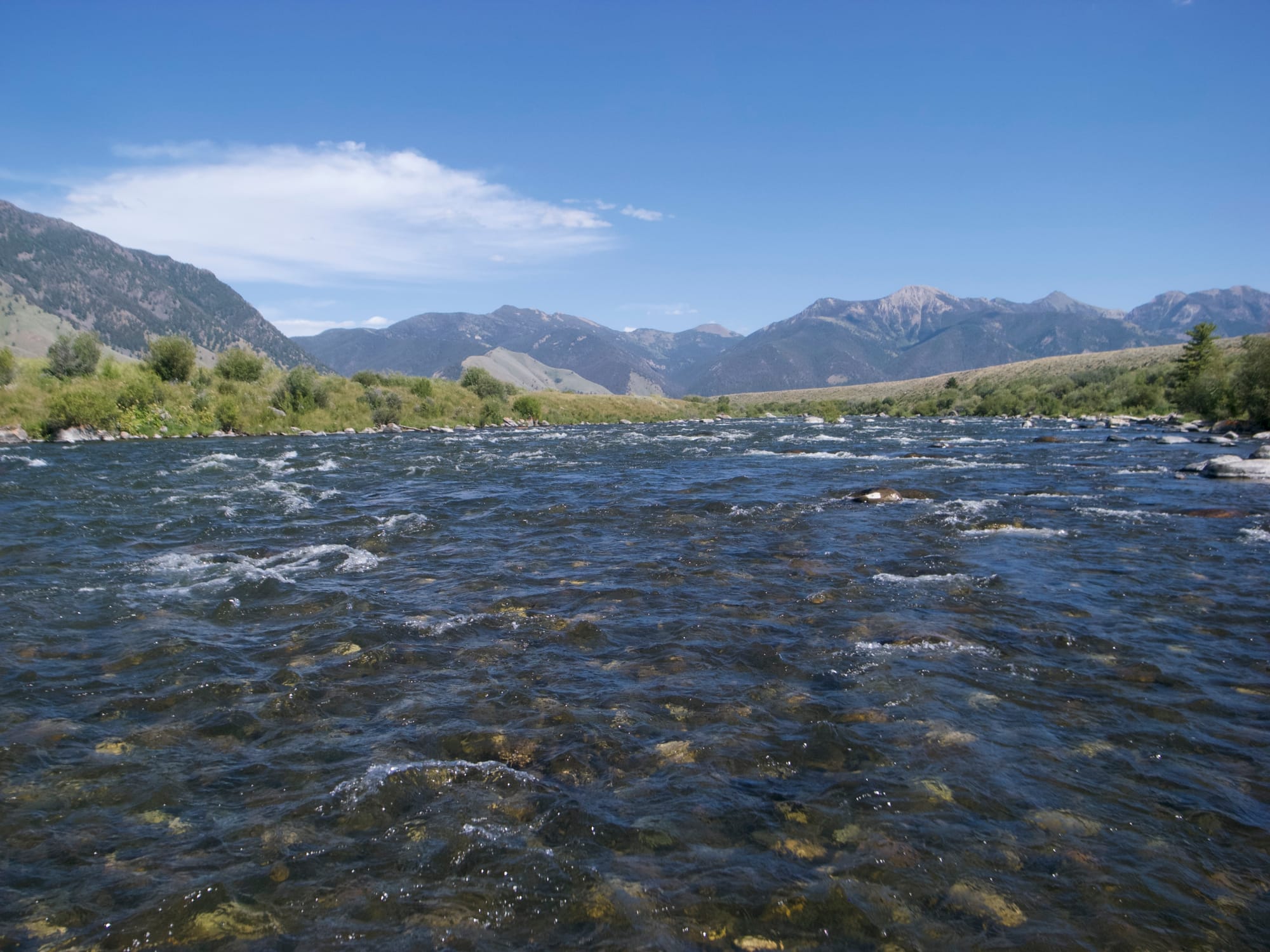
The Madison River, one of the most famous rivers for fly-fishing, is nicknamed the "50-mile riffle" because it's essentially one long riffle between Quake Lake and Ennis Lake.
Throughout that stretch, there's broken water where it's just a few feet between the bottom and the surface, with bowling-ball-sized rocks strewn about. And it makes for prime, prime trout territory. You can always tell when a drift boat is frequently run on this stretch of the Madison because it wears the scars of many collisions with rocks.
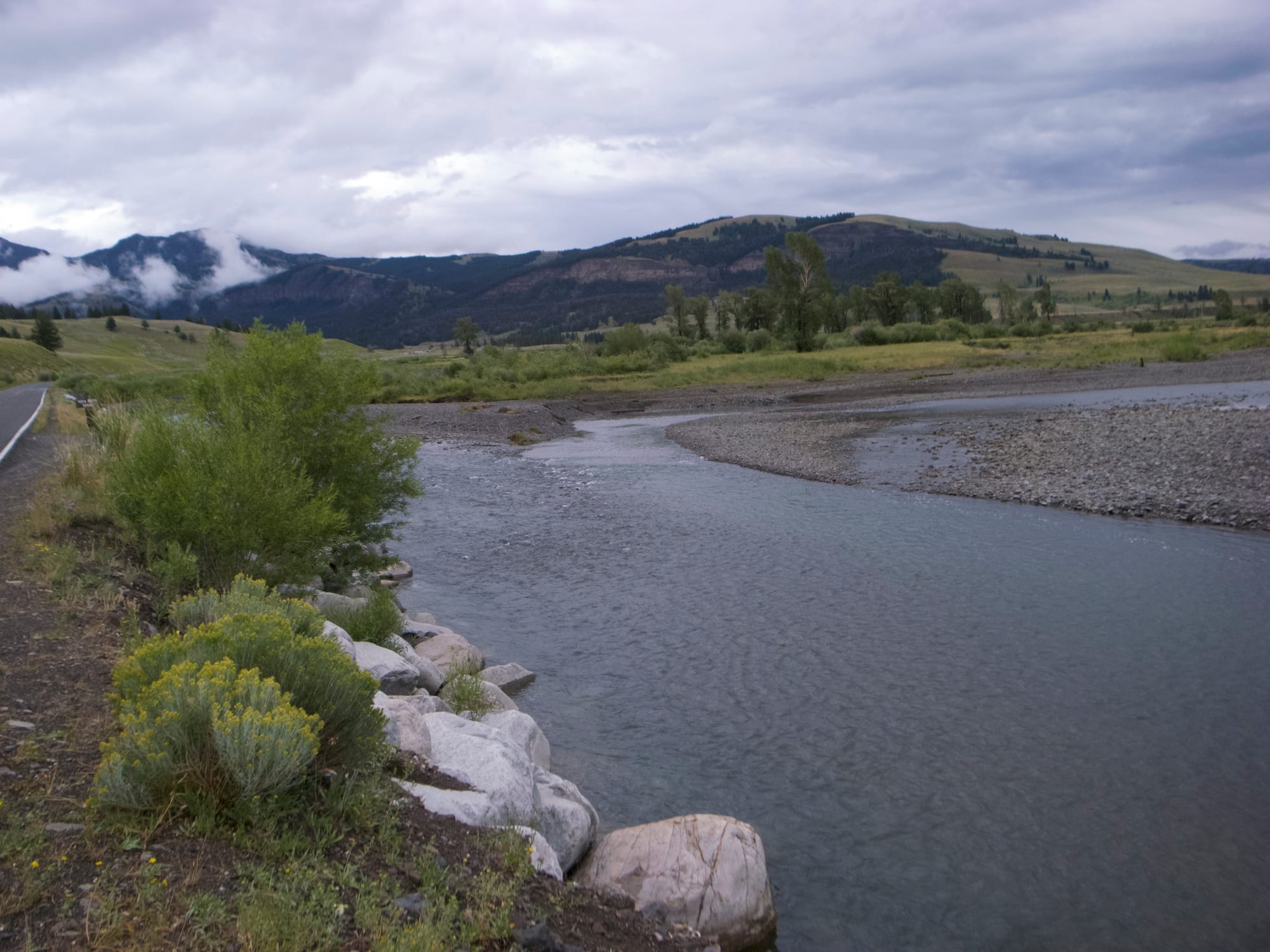
The confluence of the Lamar and the Soda Butte rivers inside of Yellowstone National Park in Montana shows how these features work together. As the Soda Butte comes in (from the left), there's a gigantic riffle, but then together the waters widen out and the river gets much calmer and moves into a run.
Once those two rivers join, they've got a lot more sort of real estate, a lot more width. And they're able to spread out and slow down a lot.
Runs
As you can see above, a run is where water gets a little bit deeper. In a run, you've still got rocks, but they're bigger, lower down, not as prominent at the surface. Maybe the river's widened up a little bit here, so we've got a little more flow. Runs have a more uniform bottom or more of a deeper current, so you'll still find boulders and whatnot at the bottom, but the top of the water will be moving more slowly due to depth.
When we swing flies for steelhead, we aim for runs that have uniform texture and surface for the long, downstream wet fly presentations. Not moving too fast. A run can be a great place to strip a streamer, after letting it sink for a few seconds, so that baitfish imitation is among bigger boulders, where fish will be hanging out. If you're in a run, and fishing under an indicator, you'll want to get your nymph(s) even deeper.
An example of a run
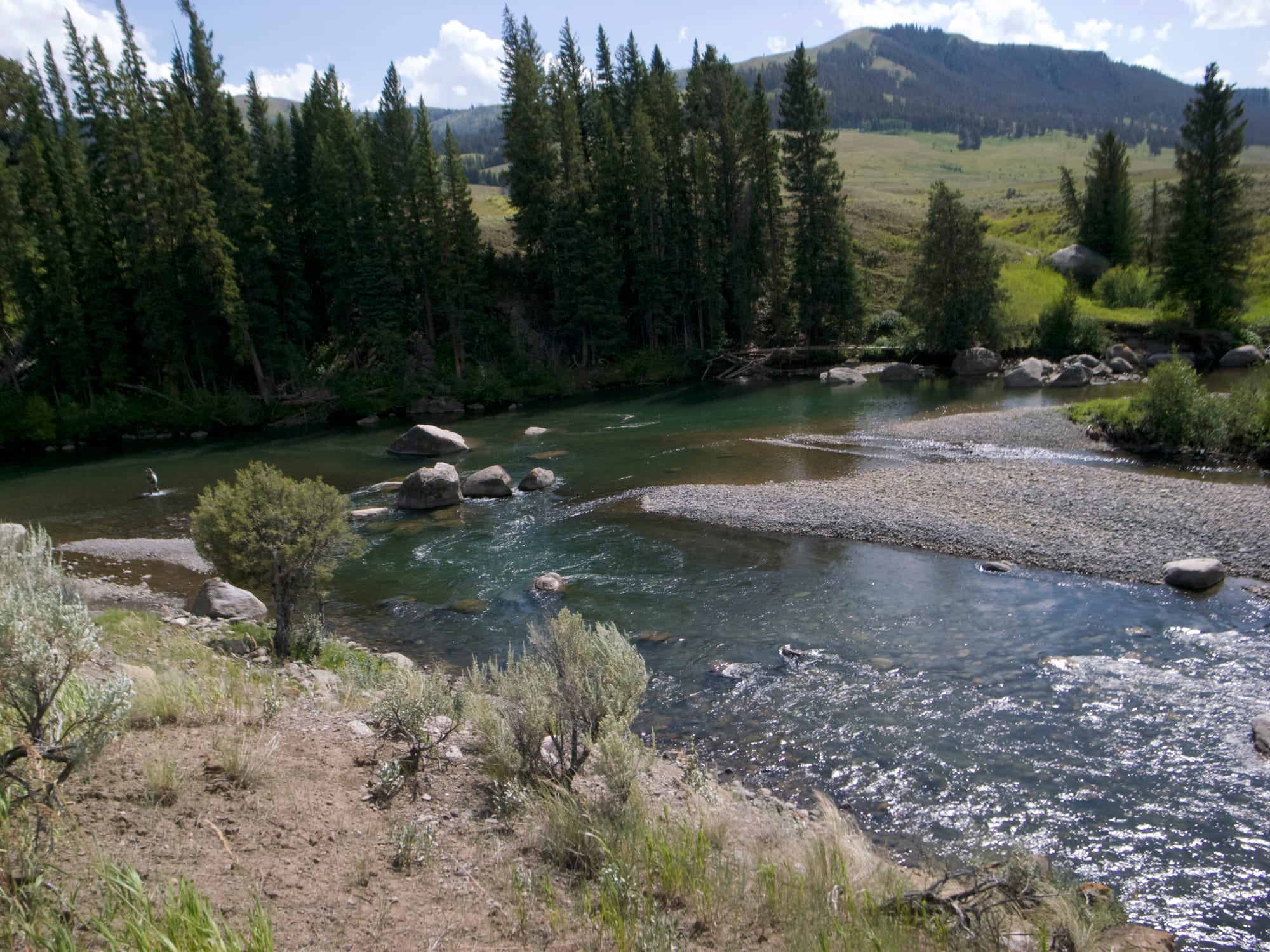
Here's a few kilometers upstream of the earlier shot, where you can see in the background, a nice run, and then then run moving through a bit of a pool as the river splits in the boulder garden in the middle background, then moves into a little bit of a run, then riffles out in the bottom right. Again, think about water speed.
Pools
A pool is where a river gets really slow, coming to a crawl, getting deep. In a pool, you'll sometimes get back eddies that will curl back up around and that will make it feel like parts of the river aren't even moving in the same direction.
Pools are typically in places where the river widens or the bottom drops out. You've still got some rocks, but they're deep, deep down there. And the water's moving so slowly through that pool it can feel almost stagnant.
If you're in a raft or drift boat and you come to a pool, you've got to row forward. You've got to push through that pool because the river slows down and the character changes. Most of the time when you're rowing in a boat on a river, you're rowing backwards to slow your boat down. In a pool, you have to row forward to make progress. If you were in a boat, you'd have to push through that to get through. Otherwise, you'd sort of just slow down and stall out.
An example of a pool
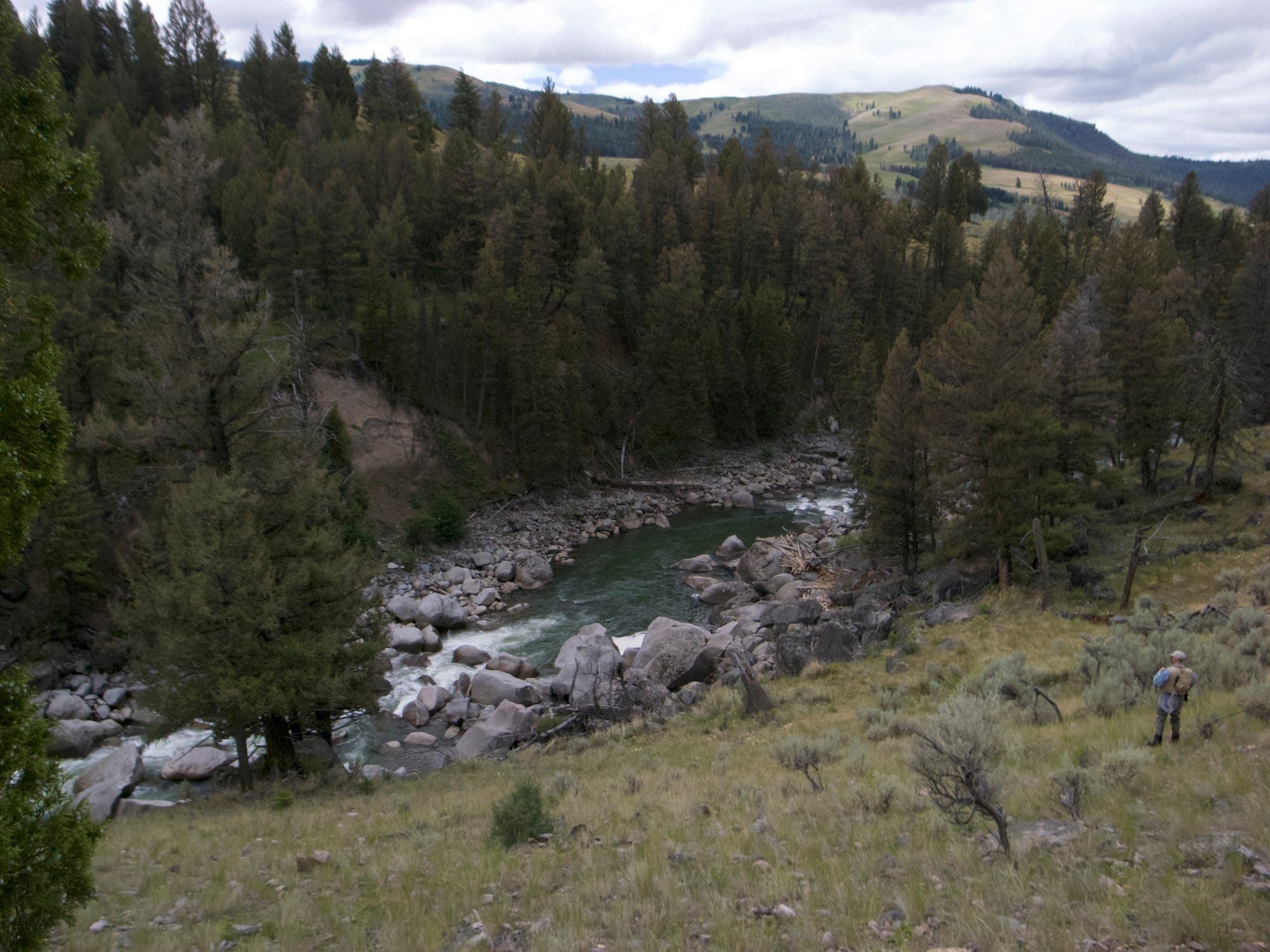
This is upstream of that earlier shot of Soda Butte Creek where you can see really pronouncedly this riffle, this bouldery section at left, with lots of whitewater, giving way to a pool, where it gets super deep for a sectionb, giving way to another riffle. A tell-tale sign is the V-slick here that disgorges itself into a the pool.
How riffles, runs, and pools happen
What you want to keep in mind as you identify the various phases and stages of a river is the idea of gradient. All rivers drop; gravity causes water to move toward its lowest point, typically sea level. The gradient of the river rate at which it drops.
The gradient of a river and the width of the river help determine whether something's going to be a riffle, a run or a pool. In areas where the river is constrained by a canyon, or rocky cliffsides, it will pool up and get deeper, by scouring the bottom.
Whereas in areas where there's a natural floodplain, and the river can expand, and take up more of the banks when it's swollen, you're more likely to encounter riffles or runs.
In addition to the sort of constriction of the river, oftentimes in a pool, the river will get wider and you'll have plenty more real estate for that water to slow down. And then you'll get different kind of currents within that pool. You'll get sort of back eddies, you'll get front eddies.
Summing up
Try and identify areas of riffles, runs, and pools from rivers you've visited, or rivers near you.
- Have you had success in one type more than another?
- Why or why not?
Once you've had a chance to do that, let's dig in further:
Reading the river:
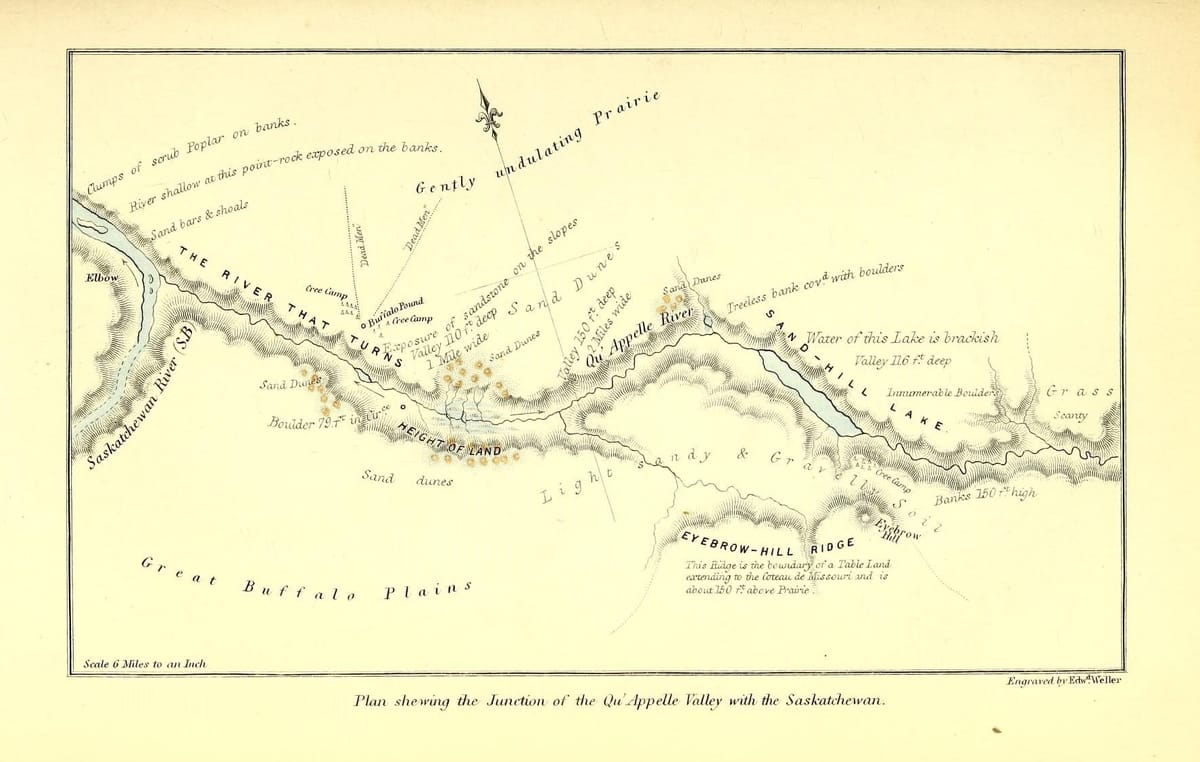
Finding places to fly fish:

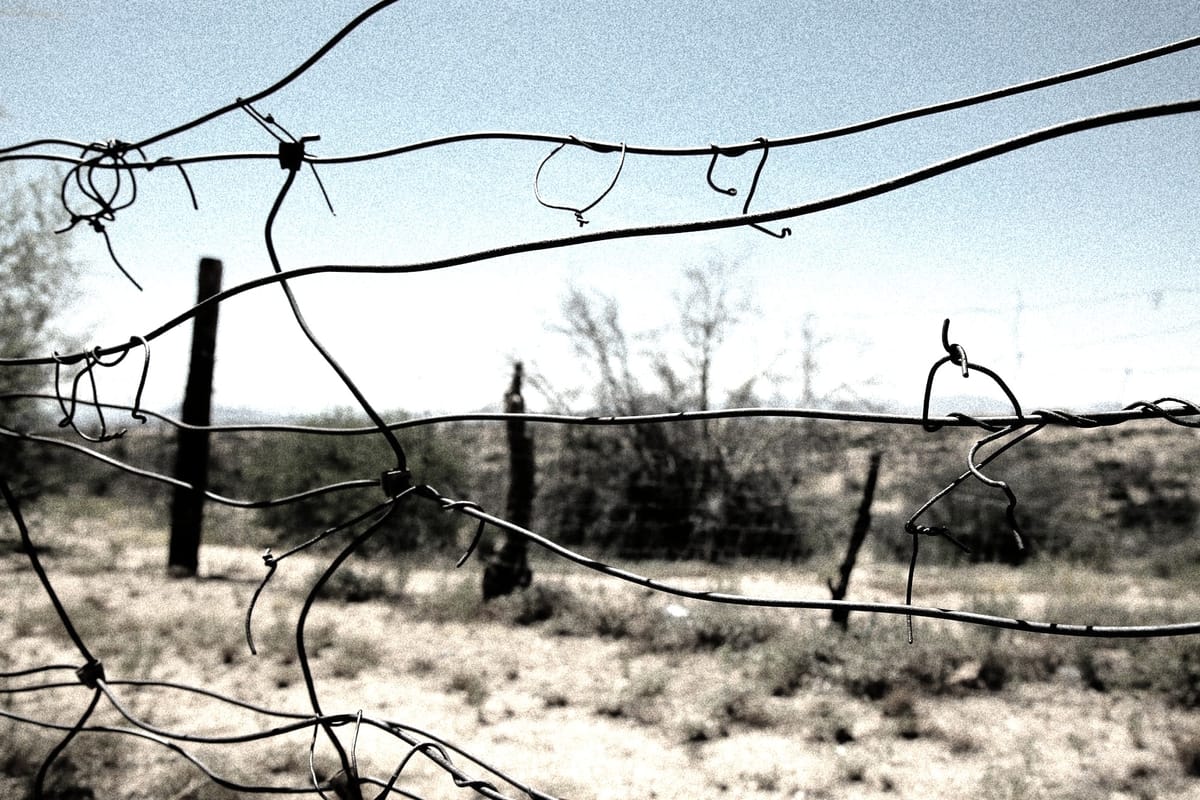
Understanding watersheds:
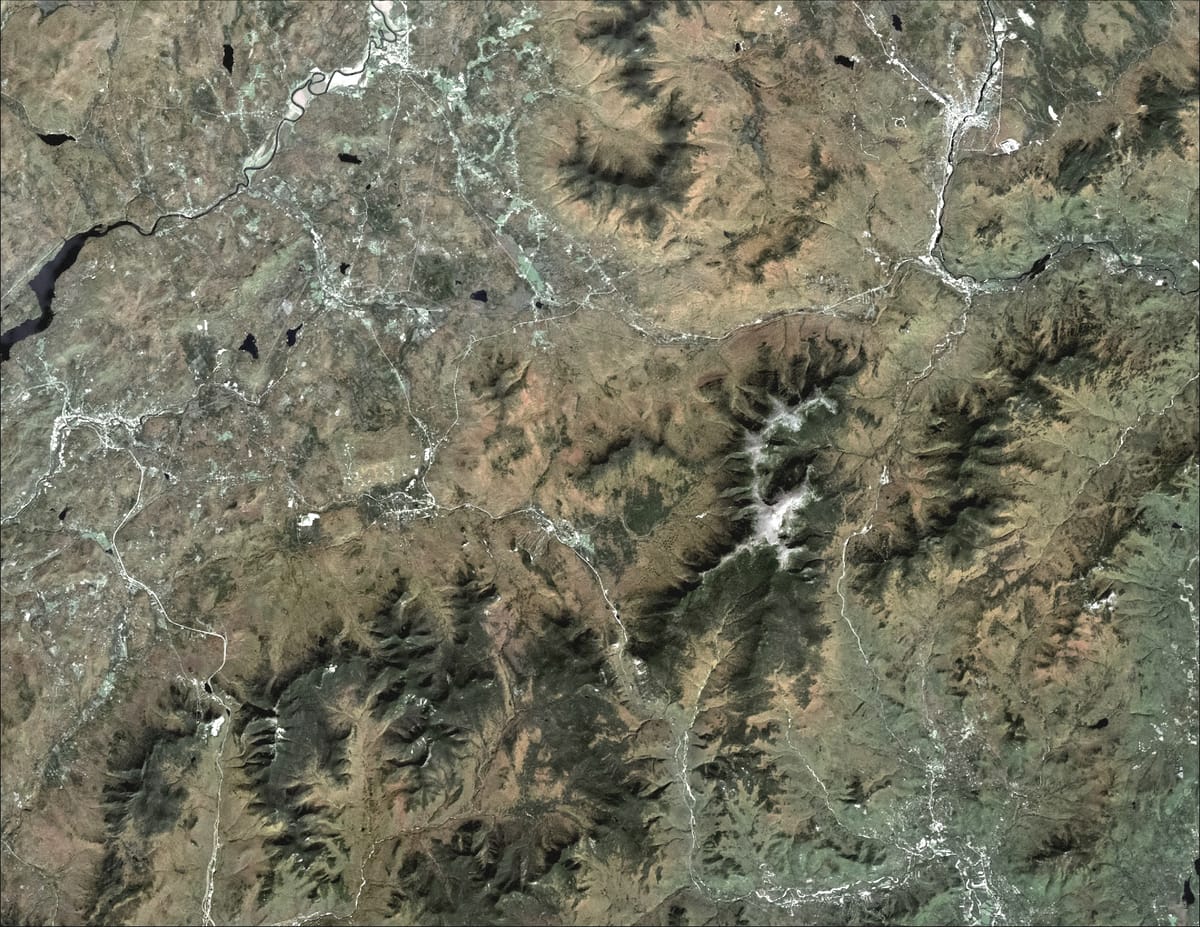
𓆟 𓆝 𓆟





